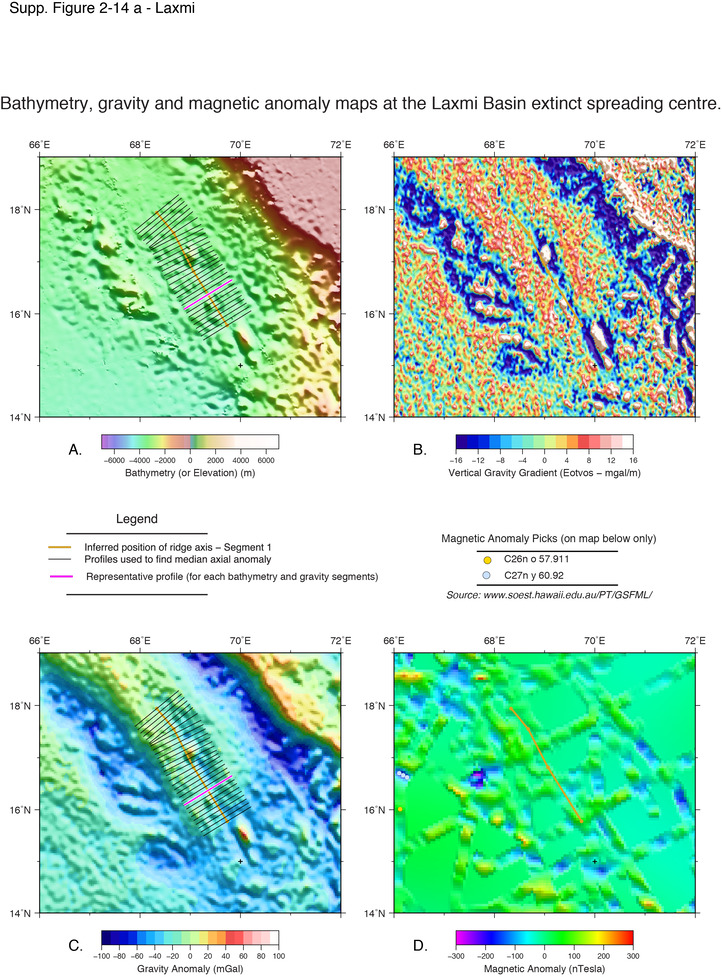| Ocean: | Indian |
| Spreading center type: | Large-scale MOR |
| Time of cessation: | Ca. 63 Ma, chron C28 (Bhattacharya et al., 1994) |
| Subsequent active spreading center: | Carslberg Ridge |
| Cessation style: | Not constrained by available data |
| Later deformation or volcanism: | Possibly volcanic ridge emplacement |
The Laxmi Basin is situated between the west coast of India and the Laxmi Ridge, that is a distance of 260 km west of the continental margin. Bhattacharya et al. (1994) collected and analyzed geophysical data from the basin and interpreted a sequence of symmetric magnetic anomalies to propose that an extinct ridge was present. Bhattacharya et al. (1994) identify the anomaly sequence as chron C33 to chron C28. The short-wavelength gravity anomaly at the inferred ridge axis alternates from low, to high and then low again from north to south, but is noted to be superimposed on a long wavelength gravity high (Bhattacharya et al., 1994).
Spreading in the Laxmi Basin has been argued to have been contemporaneous with the last phase of spreading in the Mascarene Basin, that is thought to have ceased at around the time of anomaly 27 (Cande and Patriat, 2015). A recent review and updated interpretation of magnetic anomalies (Bhattacharya and Yatheesh, 2015) suggested that the Laxmi Basin was active between chron C30no (67.6 Ma) and chron C25r (56.4 Ma), with a prolonged episode of ultraslow rifting prior to cessation. However, the authors present three alternative models that can fit the magnetic data demonstrating that the interpretation is non-unique.
The Laxmi Basin spreading center became extinct after a westward jump of the active spreading center to the Carlsberg Ridge. The Carlsberg Ridge is argued to have commenced spreading at around 62.5 Ma (Bhattacharya and Yatheesh, 2015) and propagated from north to south after initiating offshore of the Seychelles Microcontinent. Bhattacharya and Yatheesh (2015) propose that very slow spreading continued in the Laxmi Basin for up to 6 Myrs, contemporary with spreading in the Laxmi Basin. The authors attribute the ridge-jump to the presence of the Reunion plume, which they also argue was responsible for the formation of the Laxmi Basin seamounts (Bhattacharya and Yatheesh, 2015). They propose that the Laxmi Ridge may contain some continental material that was adjoined to the Seychelles microcontinent before it rifted away (Bhattacharya and Yatheesh, 2015).
The gravity signal of the Laxmi Basin spreading center is different from most other well-defined extinct ridges, with the exception of the Coral Sea extinct ridge. Few other global examples are characterised by long wavelength positive gravity signals, with superimposed short-wavelength negative anomalies. This potentially suggests a different style of initiation, spreading style, and/or cessation. The Laxmi Basin is around 250 km wide and the Coral Sea is approximately 400 km wide and both are in relatively close proximity to thick continental crustal blocks on at least one margin.
Bhattacharya, G. C., Chaubey, A. K., Murty, G. P. S., Srinivas, K., Sarma, K.V.L.N.S., Subrahmanyam, V. and Krishna, K. S., 1994. Evidence for seafloor spreading in the Laxmi Basin, northeastern Arabian Sea, Earth and Planetary Science Letters, v. 125, p. 211-220.
Bhattacharya, G. C. and Yatheesh, V. (2015). Plate-tectonic evolution of the deep ocean basins adjoining the western continental margin of India - A proposed model for the early opening scenario. In Mukherjee, S., ed., Petroleum Geosciences: Indian Contexts, Springer Geology, doi: 10.1007/978-3-319-03119-4_1.
Cande, S. C. and Patriat, P., 2015, The anticorrelated velocities of Africa and India in the Late Cretaceous and early Cenozoic, Geophysical Journal International, v. 200, p. 227-243.


